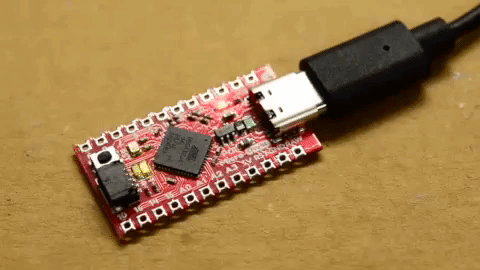

This voltage will depend on whether you have the jumper set to 5V (by default) or 3.3V. 5V is the voltage supplied to the on-board ATmega32U4.

On the other hand, if the board is powered externally, through this pin, the applied voltage can be up to 6V. V), the voltage at this pin will be about 4.8V (USB's 5V minus a Schottky diode drop). RAW is the unregulated voltage input for the Qwiic Pro Micro.V is the voltage provided from the USB connector.The back of the board also has the USB pins broken out for power. There are a variety of power and power-related nets broken out to connectors and through hole pads. Here's a map of which pin is where, and what special hardware functions it may have: Further, the I/O pins can have special abilities, like analog input. Some pins are for power input or output, other pins are dedicated I/O pins. You'll need to make sure to use an appropriate voltage regulator and components and regulate the voltage down.įor more information about the differences between the boards, make sure to pull up the schematic for both boards and read further below! The PinoutĪll of the Qwiic Pro Micro's I/O and power pins are broken out to two, parallel headers. The output current is slightly higher in the Qwiic Pro Micro which peaks at about 600mA. The new Qwiic Pro Micro uses the AP2112 3.3V voltage regulator which can handle a maximum of 6V. Finally, a Qwiic connector is populated on the bottom of the board to easily add Qwiic enabled I 2C devices.Ī subtle difference that you may not notice is the old Pro Micro used the MIC5219, which was able to handle a maximum voltage input of 16VDC. The through hole pads have castellated edges for each pin to add a lower profile in your projects should you decide build it into another assembly during production. The USB micro-b connector has been replaced with the USB type C connector. The benefit of the reset button is to quickly reset the board or place it into bootloader mode without the need to take out a piece of jumper wire. The major changes to the board that you will notice include: The board is the same size as the original Pro Micro but we added a few additional features by shrinking down some components on the board. Overall, it is functionally the same as the previous version. The Qwiic Pro Micro USBC is a revision of the original Pro Micro. The through-hole pads have castellated edges for each pin to add a lower profile in your projects should you decide to build it into another assembly during production.Before we get into installing and using the Qwiic Pro Micro, let's quickly look at the board - examine its inputs, outputs, and other hardware quirks. If you're supplying unregulated power to the board, be sure to connect to the "RAW" pin on not VCC. There is a voltage regulator on board so it can accept voltage up to 6VDC. Running at 5V and 16MHz, this board will remind you a lot of your other favorite Arduino-compatible boards but this little guy can go just about anywhere.
#Arduino pro micro usb c serial#
This tiny little board does all of the neat-o Arduino tricks that you're familiar with: nine channels of 10-bit ADC, five PWM pins, 12 DIOs as well as hardware serial connections Rx and Tx.
#Arduino pro micro usb c full#
The board is the same size as the original Pro Micro but we added a few additional features by shrinking down some components on the board such as a reset button, Qwiic connector, USB-C, and castellated pads (this makes it really handy for you custom keyboard creators out there)! Think the Pro Mini except with an ATmega32U4 on board and full USB functionality. The SparkFun Qwiic Pro Micro is a revision of the original Pro Micro and is, overall, functionally the same as the previous version.


 0 kommentar(er)
0 kommentar(er)
